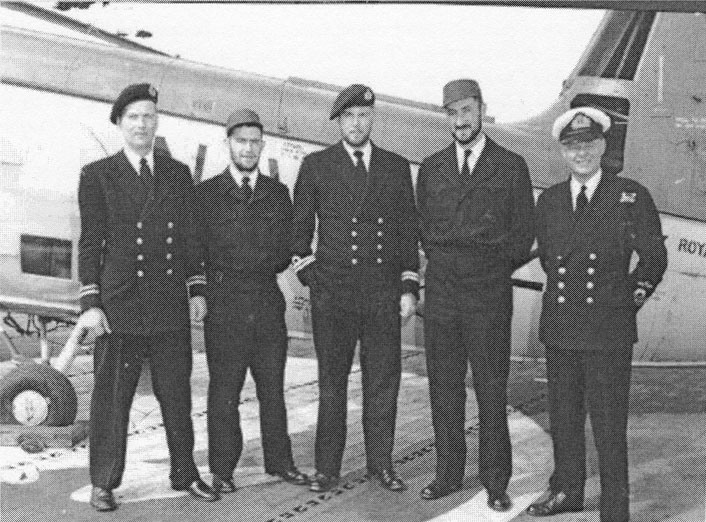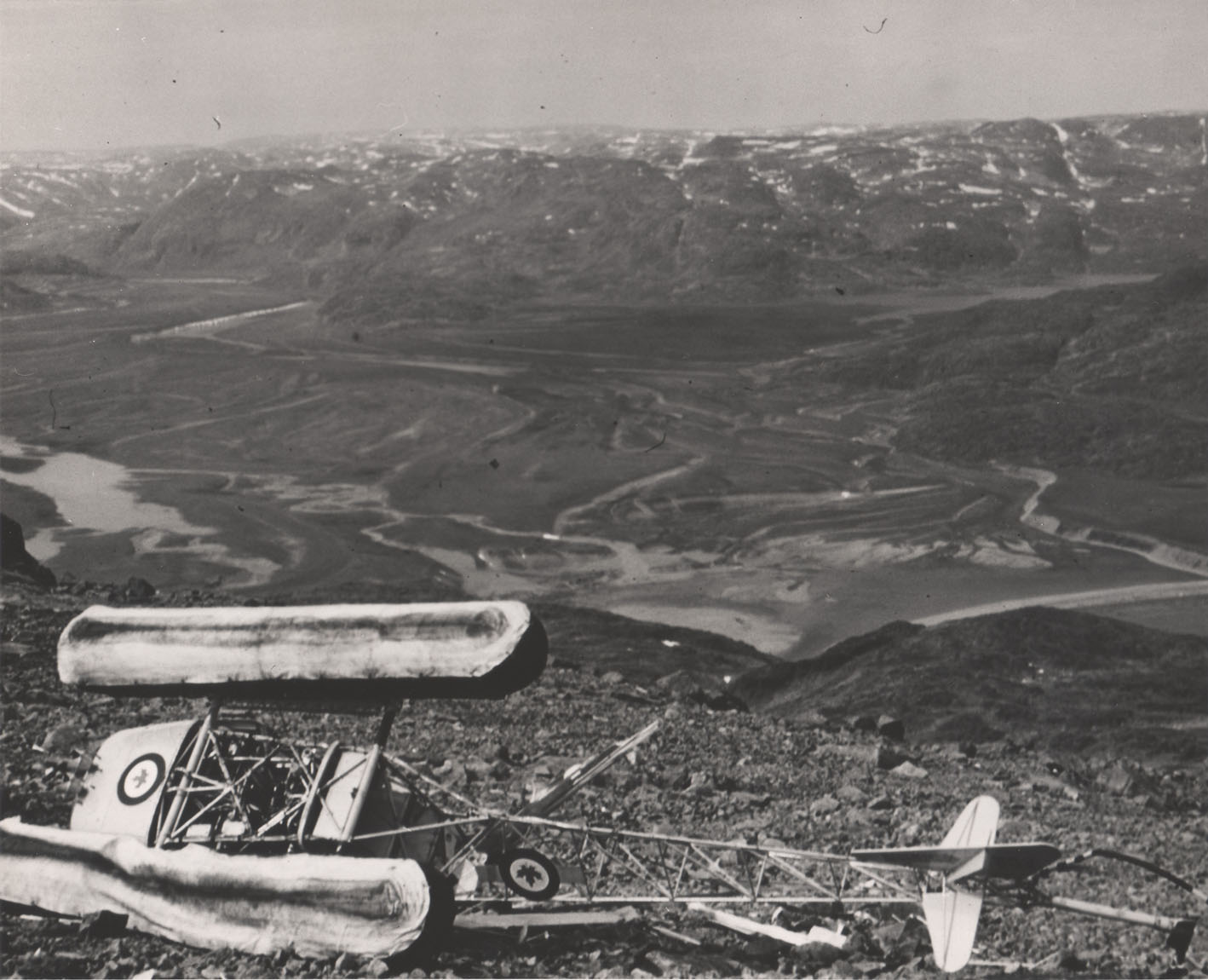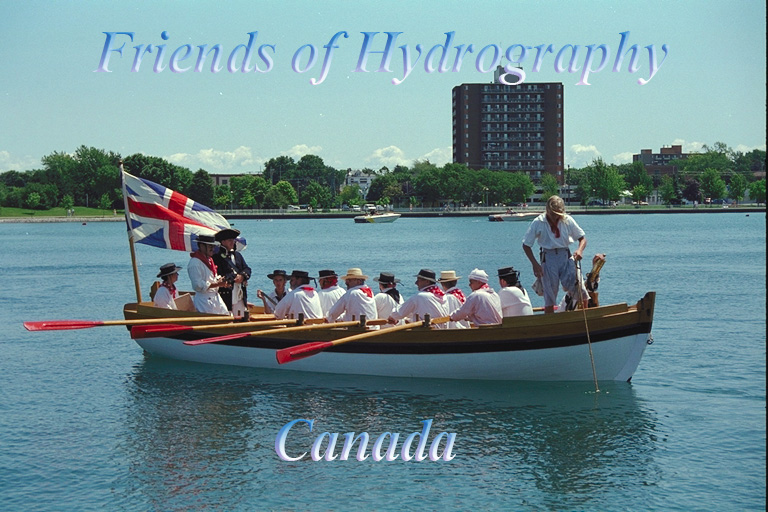Survey Hazards
First-Hand Description of Accident Events at Peter Point as compiled by R.T. Murray, LCdr RCN (retired).
July 1957

"Larry Zbitnew, Stu Dunbrack, Dave Oliphant, Sid van Dyck, Bruce Vibert
The pilot of Bell 202, LCdr Bruce VIBERT, DSC, recalls:
"My aim was to come to a hover at about 15 feet, look for a safe spot to land then settle. My approach speed disguised the lack of sufficient power, at our weight and altitude, when approaching a hover. Also, this was attempted just below the lee of the mountain crest where one must also have been caught in sever downdrafts and turbulence. On applying the collective and attempting to flare there was no response and, no time to pick an uncluttered spot to aim for. The helicopter landed heavily and rolled onto the passenger's side. Perhaps forewarned, Larry ZBITNEW's approach was far more cautious and shows that this peak was unsafe to attempt landing a Bell with very high loads."
"With regards to Dave OLIPHANT's rescue, flying HUP 247. A wide bank of cloud was fast approaching the mountain peak when he lifted off Larry ZBITNEW and Stu DUNBRACK and returned them to the ship. It was almost upon us when he came for Sid van DYCK and myself. With most of the machine out over the long and sheer south-facing wall he positioned the helicopter's door at the very edge, hence it was very easy to climb aboard. It was a beautiful piece of flying. The cloud closed in around the peak as we pulled away, and remained there for several days."
His passenger, Sidney VAN DYCK, a civilian Hydrographer attached to HMCS LABRADOR recalls:
"I was first introduced to the Bell helicopter in 1956 during Arctic survey operations aboard LABRADOR. These little yellow machines with the characteristic plastic bubble could carry two passengers and made possible much of the hydrographic survey work carried out in the Arctic by LABRADOR ."
"Early Friday morning, it must have been 6.30 or 7.00 o'clock, while operating in Frobisher Bay, we were getting ready to take some hydrographic measurements which would involve my flying to the top of Peter Point, a 2400 foot mountain in York Sound. The weather at sea level was perfect, hardly a breath of air, which was the reason for the early start. I had never liked wearing a "crash helmet", which were available on the flight deck, and I had got away with it because I was a civilian on a naval vessel. This morning CPO Joseph (Joe) MALONE pressured me once again to wear a helmet and, just to be good to him, I put one on."
"The pilot for this flight was LCdr B.F. (Bruce) VIBERT, DSC, OIC of the Detachment. After takeoff and once we had acquired sufficient altitude he headed direct for the mountain top and went straight in for a landing without the usual reconnaissance to find the best spot to land. We came in fast and made a very hard touch down on a bit of a slope. The helicopter, Bell HTL-4 202, rolled over onto the passenger side. Amongst a lot of noise of rotors shredding themselves against the rocks I was thrown forwards and hit the bubble in spite of the safety harness. Things happen rather quickly, as one must always expect the worst, which was, of course, the possibility that the helicopter might explode. The noise stopped as quickly as it had begun and I climbed out of the hole in the bubble that I had broken with the helmet on my head, LCdr VIBERT climbed out of his side door which was facing skyward. We put some distance between our selves and the helicopter and waited for what might happen. Nothing did, so we returned to the helicopter to see what might be done next. The radio was still operational so LCdr. VIBERT made contact with the ship to report the crash. By now it became clear that our landing problems had been made much worse by the strong downdrafts at the site caused by the nearby Grinnel Glacier."
"A second helicopter, Bell HTL-6 205, flown by Lt L.T. (Larry) ZBITNEW, which was heading for another hydrographic site was diverted to see if he could be of any help. He arrived not long afterwards and made a safe landing beside the wrecked Bell. By now the gusting downdrafts had become worse so Lt ZBITNEW decided to leave his civilian passenger, Stu DUNBRACK, and all expendable gear and return to the ship. He almost made it. On lifting off he was caught in a gust and his tail rotor slammed into the ground leaving him stranded. Now there were four of us. We had some emergency rations and were not too concerned even though the only other helicopter aboard HMCS LABRADOR, Piasecki HUP 247, was undergoing maintenance at that time."
"Surely we could find a way to climb down the mountain. Three sides turned out to go 2400 feet straight down with the fourth side, after a close look, remaining a very dicey possibility. This close look included a brief attempt to get over a sliding rubble field. I meant to give it a try. With a quarter inch rope tied to my belt I ventured a few steps across this rubble to what appeared to be a more solid ledge, When I looked back, I saw the person holding the other end of the rope in his hands could not possibly hold me if I started slipping. I made it back to more stable ground and counted myself lucky. Time wore on and by mid-afternoon the gusting winds were getting worse. Work on HUP 247 was proceeding at a good pace and a test flight was scheduled for late afternoon. At the same time a mountain rescue team was organized aboard LABRADOR in case the HUP could not be made serviceable. There was no chance in these increased wind conditions that the HUP pilot, Lt D.A. (Dave) OLIPHANT with crewman LS Charles CANN, could get close enough to effect a rescue so it was planned to drop some food and water to us in the early evening. The food was no problem, but the water was in jerry cans wrapped in mattresses that burst on impact. A second flight was made and this time they dropped us a lot of ice cubes in a sack. Our water problems were solved."
"The decision was made to try and to pick us up at first light the next day. That was the time of least air movement from Grinnel Glacier and therefore, hopefully, the time of least gustiness on our perch. The time came to prepare for the night. We had four sleeping bags that were carried in the helicopters in case of such an emergency. We managed to build a shelter or small lean-to using the aluminum poles from the survey stations we carried and covered them with the cut up rubber floats from the helicopter. It was not a class accommodation but quite acceptable for a one night stand. We called the ship at 0730 to report the winds had decreased. HUP 247, flown by Lt. Dave OLIPHANT got airborne and flew to the mountaintop. He hovered a few feet above the ground and the first two of us, the last ones to arrive, clambered aboard and were returned to the LABRADOR. Within half an hour he was back. The winds were starting to gust again but Lt. OLIPHANT was determined to rescue us. I will never forget his calm resolve and astute maneuvering to once again get into a hovering position so we could climb aboard. He succeeded and safely returned us to the ship by 0830.
"Once aboard LABRADOR we were handed over to the ship's doctor, Surg LCdr D.A. (Don) MACIVER, who gave us a good debriefing and a medical check-up. He gave each of us a sleeping pill and told us to go to bed. I had never before taken a sleeping pill so had no idea how long it would take to knock me out. Being cautious, I got a class of water, put it on the sink beside the bed, crawled under the blanket, took the pill with the water and quickly set the glass back on the sink. I was tired and in about 15 minutes was sound asleep."
Lt Larry ZBITNEW, the Pilot of HTL-6 205 adds:
"On arrival at the crash site of Bell HTL-4 202, I circled a couple of times and then made an approach and overshoot to determine the wind and terrain conditions. It was very gusty but I thought it was necessary to check out the scene before landing. I did land on my next approach".
"LCdr Bruce VIBERT, the pilot of Bell HTL-4 202, and I discussed what should be done next. It was decided that I should strip my helicopter of all survival equipment and leave behind my passenger, Stu DUNBRACK, a civilian Hydrographer, and return to the ship. I was to return with HUP-3 247 serno 51-16623 later when the winds subsided".
"On take-off I was hit by a vicious gust that forced bold collective action on my part. This, unfortunately, resulted in my tail rotor striking a rock. I just let the helicopter settle back onto the ground".
"Although we suspected that HUP-3 247 had some transmission problems, it was still flyable. Since my helicopter (205) had a good battery we radioed LABRADOR and gave a situation report (Sitrep). We asked for nylon rope and water to be dropped by Lt Dave OLIPHANT, flying HUP-3 247, while making a pass over our position. Peter Point was the only mountain in the vicinity that had no snow on it. The water drop didn't work (jerry cans wrapped in mattresses) but later on another flight a sack of ice cubes was dropped and this solved our problem".
"Sid VAN DYCK, the passenger in Bell HTL-4 202, and I attempted to climb or rather descend the 2400 foot mountain but after experiencing rock that crumbled underfoot we returned to the crash site with a good thirst. The ice cubes had not arrived as yet. All we had to drink was the survival rum I carried in lieu of water and the brandy that LCdr VIBERT carried in his survival kit. Our box lunches, which we always carried on flights, had orange juice so; we drank rum and orange juice. Things improved when the ice cubes arrived".
"LABRADOR maneuvered to an inlet, visible to us, just below Peter Point. At night they put on all the ships upper deck lighting and played music for us, supposedly to keep our spirits up. We radioed the ship and requested that the music be turned off'.
"Our shelter was constructed from the survey poles we carried and the rubber floats from HTL -4 202. Our sleeping bags were something we thought of earlier. In lieu of the padding in the helicopter seat cushions we had sleeping bags inserted for just such an occasion. "
"The rescue by LT Dave OLIPHANT, flying HUP-3 247, went off quite well. The wind was not as strong in the morning and we suggested to Dave that he make a reconnaissance flight first. On this flight he dropped a 15 pound fire extinguisher bottle which had been cleaned and filled with hot soup. You can imagine this missile dropping on a rocky mountain and bouncing on contact every which way. We took cover but once the bouncing ceased and we retrieved the container the soup was very much appreciated"
"LT OLIPHANT was advised not to attempt a landing but to hover about two feet above the ground. We were lifted off the mountain two at a time to keep weight to a minimum. Because of the gusty conditions the helicopter was moving about considerably. I recall grabbing onto the wheel by the cabin door and, at that moment, Dave took off. I don't know how I climbed in but one look down at 2400 feet of nothing I was spurred on. After a short flight we were back onboard LABRADOR by 0830".


